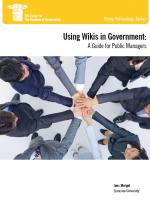
Using Wikis in Government: A Guide for Public Managers

Public leaders face the challenge of finding ways to bridge silos in their organizations. In this report, Dr. Mergel examines one tool that can help them do this—Wikis. Many of us are familiar with Wikipedia, which relies on thousands of active contributors who share their knowledge freely on a dazzling breadth of topics, with an accuracy rate rivaling that of traditional encyclopedias.
So how can government leaders spark similar outpourings of valuable knowledge - either among their employees or from the public? Dr. Mergel describes the managerial, cultural, behavioral, and technological issues that public managers face in starting and maintaining Wikis. She provides nine case studies of government organizations that launched Wikis. Each of the nine public sector organizations studied found Wikis to be valuable additions to their current workplace tools in reaching out to both employees and citizens.
Dr. Mergel doesn’t wear rose-tinted glasses, though. She observes that Wikis “are on the one hand relatively easy to create. On the other hand, maintaining collaboratively produced content while sustaining the quality and quantity of contributions over time is a formidable task for public managers.” She not only describes five challenges managers face, but also provides a checklist of best practices that public managers and Wiki administrators can use to improve chances for success.
This report is a “deep dive” into one online tool that can be used to engage employees and the public. A separate new report by the IBM Center, Using Online Tools to Engage - and be Engaged by - The Public, by Matt Leighninger, provides a broader context of the various online tools available today, showing how and when Wikis can play a role in broader engagement efforts.
We trust that this report will provide practical and concrete tips for federal managers in deciding if a Wiki makes sense for their organization, and how to best use this tool to improve collaboration within or between organizations and, where appropriate, with citizens.



